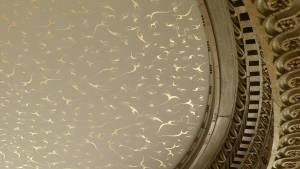Had a quiet, domestic sort of Saturday morning: I cleaned the inside of the microwave, brushed the cat, looked over a cento I’ve been trying to construct but added nothing to it, while D did interesting things with his guitar in the upstairs room he’s commandeered for the purpose. In the afternoon friends came over to take us for a walk to Greenwich.
The friends are from D’s university days who’ve lived in London for decades. He’s a playwright and actor, she’s a retired university registrar and between them they know everything worth knowing about the history of this area. One of the best stories they told, to my mind, was about the gravel in the courtyard of the Old Royal Naval College. The original gravel was substandard: full of clay it didn’t allow rain water to drain easily so the place flooded horribly. In a recent renovation of the site the heritage powers that be decided to preserve this flaw, so they sought out substandard gravel to ensure those who work there – it’s part of the University of Greenwich (I hope I’m getting all this right!) – can continue to get authentically soggy feet whenever it rains.
While next door in Queen’s House a new ceiling in the main hall by Turner Prize winning artist Richard Wright caused considerable controversy.

We didn’t go in there today, but I plan to walk over again at some point during our stay to have a good look.
Daily Observation
More of a question really: is it possible to preserve historical buildings as if they are behind glass in a museum display cabinet, and if so is that desirable? What are we doing when we preserve buildings in a way that turns them into nothing more than historical artefacts? Do we learn anything? Do we see, and sense them in the way people did when they were first built?
Header image from Visit London.
The pictures I’ve used for this post were downloaded from the internet as the photos I took with my phone have refused to upload to iCloud and, therefore, my computer. If anyone knows what’s causing this sudden breakdown in communication do tell.



Re: the “soggy feet” from substandard gravel, I’m guessing that if a permeable surface had been available at the time, the original architects would have used it! Living in a city like Savannah that has historic designation, it never ceases to amaze me that when energy efficient, but historically accurate, replacements for historic buildings are suggested the Design Review Board always vetoes them. They’d rather have inefficient, costly reproductions that only LOOK good. There needs to be a common sense approach to historical preservation. xoxo
p.s. Sorry, but I can’t help with your tech problems because I am the resident techno doofus of Blogville! ;~)
LikeLike
Exactly! We are far too hung up on appearances at the moment.
No worries about the tech problem, I found a way round it that’s a bit clunky but does the job.
LikeLike
Having lived in a Grade II listed shed, I’d say that history should be a step behind comfort. I’d never live in a listed building ever again, you have to get planning permission even if you want to change the boiler [due to moving the flue].
Sx
LikeLiked by 1 person
Ye gads!
LikeLike